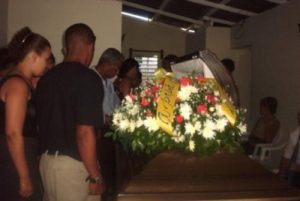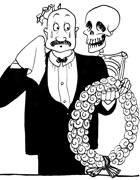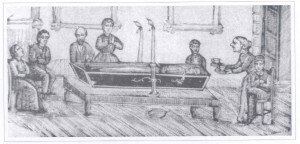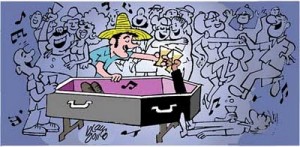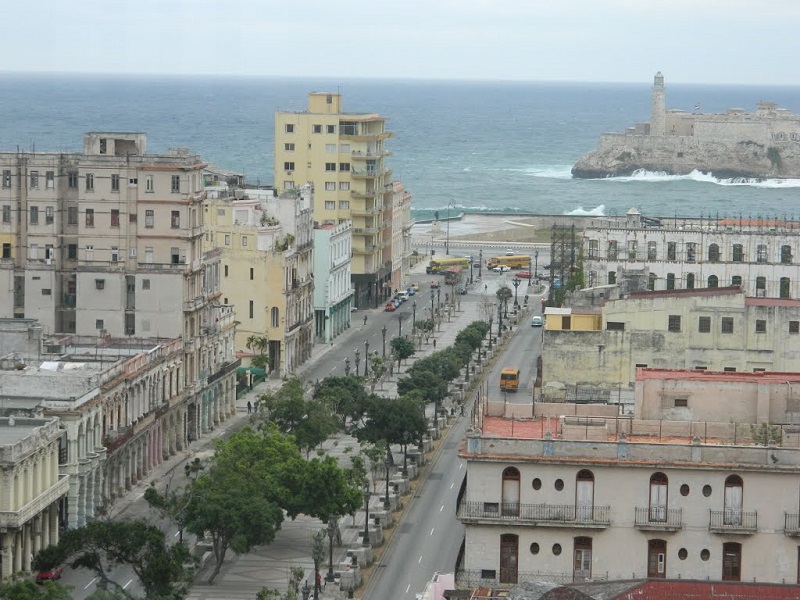TRADITIONS: THE FUNERAL IN CUBA.
When I was a kid – and not that many years ago – a wake was still a wake. An act coated solemnity even though none of them not missing the humorous guard whom the assembled listened their pujos in the absence of something more interesting to do. Then, the news of the death of an acquaintance as soon as they knew, friends and neighbors are preparing to “comply” with the deceased. The women wore black and one who was always in shirt sleeves almost welcomed the opportunity to wear the costume that was purchased when the christening of the girl and not using since she was 15, but well brushed back to be as new. A halftime trajecito, of get me one, but that still gave the plant with the tie of lists, which was the only. Or the guayabera’s thread, with the inevitable Butterfly tie, very comfortable because it came from factory with done loop and was enough to attach to neck with their clips, which were also factory.
At that time, “to meet”, people spent the whole night at the funeral home, although I had to listen to him again and again to mourners the story detailed of the last days in the hospital, the slow agony and the futile efforts of the doctor by prolonging her life. They rat phrases like “we are nothing” and others who remembered the ephemeral nature of existence and not was unusual for someone to refer again to the alive and kicking that the deceased was before dying. Family members not repressed the woes or tears to every expression of sympathy that accompanied with kisses, hugs and sound swipes on the backs and the silence and tranquility of the place occasionally breaking with poorly contained expressions of pain. Fainting. Pressure rises. Soothing, cups of coffee and juguitos. The funeral were about to take the coffin one or more family members they embraced at the box as if they should embrace the same dead. “No, don’t take”, said loudly. But it was the time and had to take it.
A wake in Knight Maulini or Fiallo was not the same. Rich and poor remained divided on the edge of the grave. And in the same Tomb. Death also had class and range and funeral service was paid accordingly. There was the middle term, which was which gives the national funeral home. The funeral of middling or its agents roamed hospitals and clinics to find out who they was about to die and go falling in love with family members to the business not to escape them. A business that disputed sometimes before a body still warm. Despite the differences and although the dead not protested, the same was a wake that Rivero in Luyanó or olive: burial was not leaving until the funeral is not paid. They were not worth pleas and promises. And there were areas in the cemetery. According to the location of the vault, was the economic position of the dead. A necropolis which reproduced in his paintings and in the luxury of the pantheons the city of the living, with its Country Club, their Miramar, his Vedado, its comes and Pon…
IT COMES FROM THE PAST.
In Cuba, the custom of ensuring a corpse comes back, i.e. Spain and Africa and is as old among us that one of our first literary publications, the paper newspaper in Havana, in its edition of December 4, 1804, appears a “summary of what tends to happen in the funeral”. He has the author one day outside a house where a corpse is watched, one of the friends of the dead, to encourage him to enter, approached him and said to him: “Pass you to have fun, for everyone there and for more to come”.
According to the historian Emilio Roig de Leuchsenring, wakes at that time were true orgies. It was done in Andalusia, and mainly in Granada, where the “happy rise to the heaven of an Angel” was accompanied with a big party. While parents mourned the loss, his friends sang and danced with crazy joy next to the body of the child. Fernando Ortiz, for his part, points out that that of a party of a tragic fact was reinforced by Blacks arrived as slaves.
Here perhaps should be specified that, unlike what happens in the cities, in the Cuban camps wake is not synonymous with mortuary. Our farmers are a holy, and not in his day, thanks or payment of a promise. Or watch a pig while cooking in pua, and in both cases there are music and dance and drink runs. In 1875, Esteban Pichardo, in his provincial almost reasoned voices and Cuban phrases dictionary, says that wake is “the action and effect of ensuring in meeting a person deceased or next to die… If the body is of a child belonging to the gentualla, the wake becomes fun. In vulgar Havana, there are also funeral of tripe, roast suckling pig, etc., as it is the replacement for the late for dinner too late, drinking, dancing…” It also says: “the night spent in conversation to low voice, interspersing later tricks and treats, coffee and other drinks”.
SERVED CHOCOLATE.
Because if in the funeral today is through sometimes a bottle of rum, and more than one also, only frighten grief and not anything else, of course, eat it was common practice in the wakes of yesteryear. The English painter Walter Goodman, who lived in Santiago between 1864 and 1869, recalls in his book an artist in Cuba a wake attended in that city because the family wanted a portrait of the deceased. There the concurrent drowned his sorrow in the Cup that are happy and lively talk and sweets, cakes, coffee, chocolate and cigars were served. In the twenties of the last century, the poet Rubén Martínez Villena, in his “song of the posthumous sainete”, imagined his own wake where “desired chocolate cups / will be tasty patterns in conversation”.
In a now unknown and forgotten book, Nueva Granada trip to China and China to France (1881), of which there is a single copy in Cuba, its author, the Colombian Nicolás Tanco and gunsmith, who arrived in Havana in 1851 and was enriched by trafficking in Chinese, this vivid image of a wake of then is drawn.
“From the moment that has killed one, is placed the corpse in the middle of the room on a bier that is usually very luxurious, covered with velvet black and full of a multitude of ornaments of the case… The poor dead is very still and quiet in the midst of tapestries and candles, but the concurrence of friends does not remain in the same way. It is sad to say it, but the scenes that are passed at the moment are scandalous: instead of the composure and the silence which demands an act of this kind, reigns the most pomp and noise. All the friends gather in a room where usually are the relatives of the deceased and speak of all the materials aloud as if they were at home.
When approaching the midnight moves on to the dining room, and there awaits them a magnificent dinner where with the smoke from the champagne and slices of ham is usually somewhat mitigate the pain. There, the sound of corks, begin the consolations of each friends… The little children rise from the table and chewing their good wedges approach to contemplate the corpse. In a special room there are game tables for fans…”
THE FUNERAL.
I’ve never seen eating at a wake, and perhaps now return desired chocolate cups, but yes I attended child some that took place in the home of the deceased. They hired the services of a funeral home, putting coffin, candles, the crucifix and the truck, and mourners called for chairs borrowed from residents. In 20 to 30 years there was in Havana a famous funeral refers to the home viewing. It was Raola. Already since long before there were funeral homes in this capital. Knight, for example, was founded in 1857, in Central Havana, and there was until in the 1940s or maybe earlier moved to 23 and M, which was not then the Central corner which would later be. And since this talk about, remember the time in Santiago de Cuba, without having to sleep, I spent all night, with my stuff’s wandering reporter and almost tramp, at the funeral home of Bartholomew.
Do not say that pain for the loss of a loved one is minor, but death, “rather than daily passes”, it is otherwise. Today the funeral have been simplified. At times do not last 24 hours that formerly were de rigueur. That exact word for a bad night. Few people spend night complete next to a dead man because under the pretext of the transport, “which is bad”, or unavoidable commitments in the next morning, at eleven, at the latest, starts the rout. Of those who “met” because many are the crazy goat and neither the funeral behave by close as his friendship with the dead.
Agencies/CiroBianchiRoss/InternetPhotos/TheCubanHistory.com
THE CUBAN HISTORY, HOLLYWOOD.
Arnoldo Varona, Editor
TRADICIONES: LOS VELORIOS EN CUBA
Cuando yo era niño –y no hace de eso tantos años- un velorio era todavía un velorio. Un acto revestido de solemnidad aunque no faltase en ninguno de ellos el chistoso de guardia a quien los reunidos escuchaban sus pujos a falta de algo más interesante que hacer. Entonces, tan pronto se conocía la noticia de la muerte de un conocido, amigos y vecinos se aprestaban a “cumplir” con el difunto. Las mujeres vestían de negro y aquel que andaba siempre en mangas de camisa casi agradecía la oportunidad para volver a lucir el traje que se compró cuando el bautizo de la niña y que no usaba desde que ella cumpliera los 15, pero que bien cepillado volvía a quedar como nuevo. Un trajecito de entretiempo, de apéame uno, pero que todavía daba el plante con la corbata de listas, que era la única. O la guayabera de hilo, con la infaltable corbata de mariposa, muy cómoda porque venía de fábrica con el lazo hecho y bastaba con sujetarla al cuello con sus presillas, que también eran de fábrica.
En ese tiempo, “por cumplir”, la gente se pasaba la noche entera en la funeraria, aunque tuviera que escucharle una y otra vez a los dolientes el relato pormenorizado de los días pasados en el hospital, la lenta agonía y los esfuerzos vanos del médico por prolongarle la vida. Menudeaban frases como “no somos nada” y otras que recordaban lo efímero de la existencia y no era raro que alguien aludiera una y otra vez a lo vivito y coleando que andaba el difunto antes de morirse. Los familiares no reprimían los ayes ni las lágrimas ante cada expresión de pésame que se acompañaban con besos, abrazos y sonoros manotazos en las espaldas y el silencio y la tranquilidad del lugar se rompían de cuando en cuando con manifestaciones de dolor mal contenidas. Desmayos. Subidas de presión. Calmantes, tazas de café y juguitos. Cuando los funerarios se disponían a llevarse el ataúd uno o más familiares se abrazaban a la caja como si abrazaran al muerto mismo. “No, no se lo lleven”, decían a voz en cuello. Pero era la hora y había que llevárselo.
No era lo mismo un velorio en Caballero que en Maulini o en Fiallo. Pobres y ricos seguían divididos al borde de la tumba. Y en la tumba misma. La muerte tenía también rango y clase y el servicio fúnebre se pagaba en consecuencia. Existía el término medio, que era el que brindaba la funeraria Nacional. Los funerarios de medio pelo o sus agentes recorrían clínicas y hospitales para enterarse de quién en ellos estaba a punto de fallecer e ir enamorando a los familiares a fin de que no se les escapara el negocio. Un negocio que se disputaban en ocasiones ante un cuerpo todavía caliente. Pese a las diferencias y aunque el muerto no protestara, lo mismo daba un velorio en Rivero que en Luyanó o en Oliva: el entierro no salía hasta que no se pagara el funeral. No valían súplicas ni promesas. Y había zonas en el cementerio. Según la ubicación de la bóveda, así era la posición económica del muerto. Una necrópolis que reproducía en sus cuadros y en el lujo de los panteones la ciudad de los vivos, con su Country Club, su Miramar, su Vedado, su Llega y Pon…
VIENE DEL PASADO.
En Cuba, la costumbre de velar un cadáver viene de atrás, es decir, de España y África y es tan vieja entre nosotros que ya en una de nuestras primeras publicaciones literarias, El Papel Periódico de La Habana, en su edición correspondiente al 4 de diciembre de 1804, aparece un “Extracto de lo que suele acontecer en los velorios”. Cuenta su autor que un día, frente a una casa donde se velaba un cadáver, uno de los amigos del muerto, para animarlo a entrar, se le acercó y le dijo: “Pase usted a divertirse, que para todos hay y para más que vengan”.
En opinión del historiador Emilio Roig de Leuchsenring, los velorios en aquella época eran verdaderas orgías. Así sucedía en Andalucía, y principalmente en Granada, donde la “feliz subida al cielo de un angelito” se acompañaba con una gran fiesta. Mientras los padres lloraban la pérdida, sus amigos cantaban y bailaban con loca alegría junto al cuerpo sin vida del niño. Fernando Ortiz, por su parte, puntualiza que eso de hacer una fiesta de un hecho luctuoso fue reforzado por los negros llegados como esclavos.
Quizás aquí sea conveniente precisar que, a diferencia de lo que sucede en las ciudades, en los campos cubanos velorio no es sinónimo de mortuorio. Nuestros campesinos velan a un santo, y no precisamente en su día, por agradecimiento o en pago de una promesa. O velan a un cerdo mientras se asa en púa y en ambos casos hay música y baile y corre la bebida. Ya en 1875, Esteban Pichardo, en su Diccionario provincial casi razonado de voces y frases cubanas, afirma que velorio es “la acción y efecto de velar en reunión a una persona difunta o próxima a morir… Si el cadáver es de algún niño perteneciente a la gentualla, el velorio se convierte en diversión. En La Habana vulgar también hay velorios de mondongo, lechón asado, etc., conforme sea el sustituto del difunto para cenar muy tarde, beber, bailar…” Dice además: “La noche pasa en conversación a voz baja, intercalándose más tarde sus golosinas, café y otras bebidas”.
CHOCOLATE SERVIDO.
Porque si en los velorios de hoy se ve pasar a veces una botella de ron, y más de una también, solo por espantar el pesar y no por otra cosa, desde luego, comer era práctica habitual en los velorios de antaño. El pintor inglés Walter Goodman, que vivió en Santiago entre 1864 y 1869, recuerda en su libro Un artista en Cuba un velorio al que asistió en esa ciudad porque los familiares querían un retrato del difunto. Allí los concurrentes ahogaban su tristeza en la copa que alegra y en la charla animada y se sirvieron dulces, bizcochos, café, chocolate y puros habanos. En los años 20 del siglo pasado, el poeta Rubén Martínez Villena, en su “Canción del sainete póstumo”, imaginaba su propio velorio donde “las apetecidas tazas de chocolate/ serán sabrosas pautas en la conversación”.
En un libro hoy desconocido y olvidado, Viaje de Nueva Granada a China y de China a Francia (1881) del que existe un solo ejemplar en Cuba, su autor, el colombiano Nicolás Tanco y Armero, que llegó a La Habana en 1851 y se enriqueció con la trata de chinos, se traza esta imagen vívida de un velorio de entonces.
“Desde el instante en que ha muerto alguno, se coloca el cadáver en medio de la sala sobre un catafalco que generalmente es muy lujoso, cubierto de terciopelo negro y lleno de multitud de adornos del caso… El pobre muerto se halla muy quieto y tranquilo en medio de colgaduras y cirios, pero la concurrencia de amigos no permanece del mismo modo. Triste es decirlo, pero las escenas que se pasan en estos momentos son escandalosas: en lugar de la compostura y el silencio que exige un acto de esta clase, reina la mayor algazara y ruido. Todos los amigos se reúnen en un cuarto donde generalmente están los parientes del finado y hablan de todas las materias en voz alta como si estuvieran en su casa.
Cuando se acercan las doce de la noche se pasa al comedor, y allí les aguarda una magnífica cena donde con el humo del champaña y las tajadas de jamón se suele mitigar un tanto el dolor. Allí, al ruido de los corchos, empiezan los consuelos de cada cual a los allegados… Los niñitos se levantan de la mesa y mascando sus buenas tajaditas se acercan a contemplar el cadáver. En un cuarto especial hay mesas de juego para los aficionados…”
EL FUNERARIO.
Nunca he visto comer en un velorio, y quizás vuelvan ahora las apetecidas tazas de chocolate, pero sí asistí de niño a algunos que tuvieron lugar en la propia vivienda del difunto. Se contrataban los servicios de una casa fúnebre, que ponía el ataúd, las velas, el crucifijo y el carro, y los dolientes pedían sillas prestadas entre los vecinos. En los años 20 y 30 hubo en La Habana un funerario célebre en lo que al velorio casero se refiere. Se apellidaba Raola. Ya desde mucho antes existían funerarias en esta capital. Caballero, por ejemplo, se fundó en 1857, en Centro Habana, y allí estuvo hasta que en los años 40 o quizás antes se trasladó para de 23 y M, que no era entonces la esquina céntrica que sería después. Y ya que sobre esto hablamos, recuerdo la ocasión en que en Santiago de Cuba, sin tener donde dormir, pasé toda una noche, con mis bártulos de reportero errante y casi vagabundo, en la funeraria Bartolomé.
No digo que el dolor por la pérdida de un ser querido sea menor, pero la muerte, “algo que diariamente pasa”, se ve de otra manera. Hoy los velorios se han simplificado. A veces no duran las 24 horas que antes se hacían de rigor. Palabra esa exacta para una mala noche. Son pocos los que pasan la noche completa junto a un muerto pues con el pretexto del transporte, “que está pésimo”, o de compromisos ineludibles en la mañana siguiente, a las once, a más tardar, empieza la desbandada. De los que “cumplieron” porque muchos se hacen el chivo loco y ni por la funeraria se portan por estrecha que fuera su amistad con el muerto.
Agencies/CiroBianchiRoss/InternetPhotos/TheCubanHistory.com
THE CUBAN HISTORY, HOLLYWOOD.
Arnoldo Varona, Editor.



